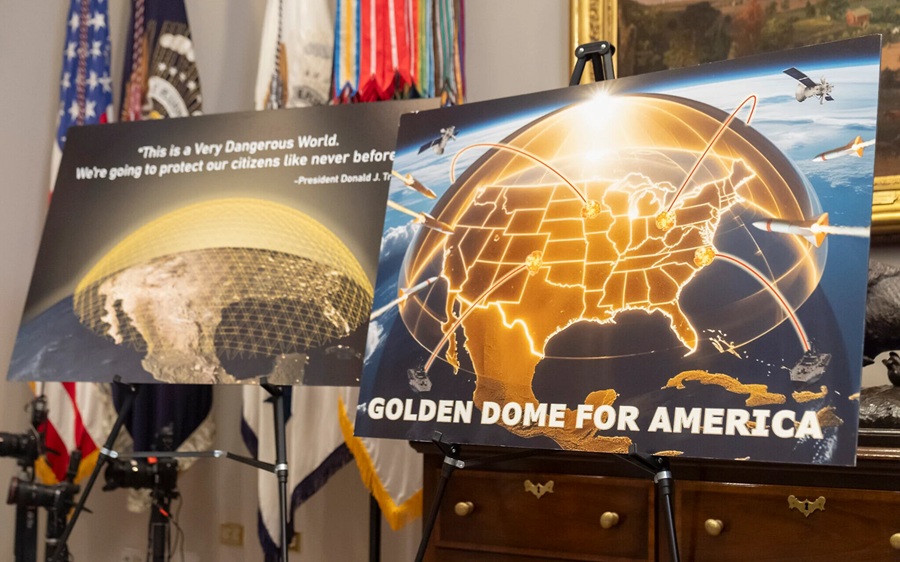In an era of growing global instability, with rising tensions between world powers and the constant threat of rogue nations acquiring nuclear capabilities, national defense has taken center stage in political and military discourse. Among the many ideas floated in recent years, one particularly attention-grabbing concept comes from former President Donald Trump: the so-called "Golden Dome" — a missile defense shield meant to protect the United States from ballistic missile attacks, much like Israel’s Iron Dome but on a vastly larger and more ambitious scale.
But can such a system actually work? Is it technologically feasible? And what would it take to turn Trump's "Golden Dome" from campaign rhetoric into real-world protection? Let’s break it down for the general reader.
What Is the “Golden Dome”?
The “Golden Dome” is not a formally defined defense program yet. It’s a term coined by Trump during campaign events and interviews, referring to an advanced missile defense shield designed to protect the United States from incoming threats such as nuclear-tipped ballistic missiles, including those launched by adversaries like North Korea, Iran, China, or Russia.
Trump has spoken about this concept as a form of “space-based” or “all-encompassing” protection, suggesting something that can detect, intercept, and destroy threats before they reach American soil — a high-tech umbrella shielding the nation.
The concept has been compared to Israel's Iron Dome, a real and operational missile defense system that has had notable success intercepting short-range projectiles, including rockets fired from Gaza. However, the Iron Dome covers a small area and deals with relatively slow-moving targets. A system to defend the entire continental U.S. from intercontinental ballistic missiles (ICBMs) would require a significantly more complex and expensive architecture.
Understanding Missile Defense
To evaluate whether the "Golden Dome" is realistic, it’s helpful to understand the basics of how missile defense works.
Ballistic missiles typically follow a three-stage path:
- Boost Phase: The missile is launched and accelerates into space.
- Midcourse Phase: It coasts through space toward its target, often deploying multiple warheads or decoys.
- Terminal Phase: The warhead re-enters the atmosphere and heads toward its target.
To defend against such a threat, systems must detect the launch, track the missile through each phase, and attempt interception — all within minutes or even seconds.
The U.S. already has some missile defense systems in place:
Ground-based Midcourse Defense (GMD): Designed to intercept ICBMs during the midcourse phase.
Aegis Ballistic Missile Defense: Ship-based interceptors that can target missiles in early phases.
THAAD (Terminal High Altitude Area Defense): Focuses on intercepting short- and medium-range missiles during the terminal phase.
However, these systems have limited coverage and reliability. They have shown mixed success in tests, and they are not designed to provide complete protection across the entire nation.
Technological and Financial Hurdles
Creating a “Golden Dome” would mean developing a nationwide, possibly even space-based, missile defense system capable of detecting and neutralizing threats from any direction, at any time. That’s a massive technical challenge. Here’s why:
- Speed and Precision: ICBMs can travel at speeds up to 15,000 mph. Detecting and intercepting such threats with split-second timing is incredibly complex.
- Multiple Warheads and Decoys: Modern ICBMs can carry MIRVs (Multiple Independently targetable Reentry Vehicles) and decoys, complicating tracking and interception.
- Space-based weapons: While a space-based defense system sounds futuristic, deploying and maintaining weapons in orbit is incredibly expensive and raises legal issues under international treaties.
- Cost: Experts estimate that a nationwide missile shield could cost hundreds of billions, even trillions of dollars. The existing GMD system alone has already cost over $40 billion with limited effectiveness.
Geopolitical and Strategic Implications
Even if technically feasible, a “Golden Dome” would have far-reaching implications for global security.
- Arms Race: If the U.S. could fully shield itself from nuclear retaliation, adversaries might feel compelled to build more missiles, more warheads, or develop alternative weapons to ensure their deterrence remains credible.
- Undermining Deterrence: The concept of Mutually Assured Destruction (MAD) has prevented nuclear war for decades. A foolproof shield could upset this balance and provoke instability.
- International Agreements: Deploying such a system might violate treaties like the Outer Space Treaty or the Anti-Ballistic Missile (ABM) Treaty, which the U.S. left in 2002 but which still affects international norms.
Is It Just Campaign Rhetoric?
Critics argue that Trump’s "Golden Dome" is more symbolic than strategic, designed to appeal to voters concerned about national security without offering a clear policy roadmap. There is no formal plan, budget, or technical blueprint released by Trump or his team. Defense experts and Pentagon officials have not publicly endorsed such a system, and it’s unclear whether the defense industry could deliver it anytime soon.
However, it’s worth noting that Reagan’s Strategic Defense Initiative (SDI) — dubbed “Star Wars” — faced similar criticism in the 1980s, yet it reshaped defense thinking and spurred important advances in missile tracking and space technology.
Conclusion: Dream or Defense Reality?
The idea of a "Golden Dome" missile shield is bold, dramatic, and emotionally compelling. It taps into the desire for absolute safety in an increasingly dangerous world. But can it actually work?
As of now, the answer is not yet. The technological, financial, and political challenges are immense. Current U.S. missile defenses are improving, but a nationwide, ironclad missile shield remains aspirational.
Still, if tensions continue to rise with nations like Russia, China, and North Korea, there may be growing public and political will to revisit such ambitious programs. The real question might not be “can we do it?” but rather “should we?”
